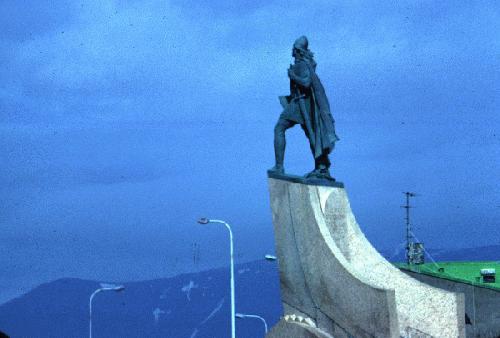|
Leif Ericson Biography (from ODIN) 1000 AD
By Linn Ryne In 986, Norwegian-born Eirik Thorvaldsson, known as Eirik the Red, explored and colonized the southwestern part of Greenland. It was his son, Leiv Eiriksson, who became the first European to set foot on the shores of North America, and the first explorer of Norwegian extraction now accorded worldwide recognition. The date and place of Leiv Eiriksson's birth has not been definitely established, but it is believed that he grew up on Greenland. The Saga of Eric the Red relates that he set sail for Norway in 999, served King Olav Trygvasson for a term, and was sent back to Greenland one year later to bring Christianity to its people.
Eiriksson and his men spent the winter in Vinland, at a place they named Leifsbud-ir, returning to Greenland the following year, 1001. It was left to Eiriksson's brother, Thorvald, to make the next voyage to the new-found territory, for strange as it may seem, Leiv Eiriksson never returned there. Subsequent attempts at settlement of Vinland were unsuccessful, due to strong friction between the Viking settlers and the native North Americans. Though many still regard Christopher Columbus as the discoverer of the New World, Eiriksson's right to this title received the stamp of official approval in the USA when in 1964 President Lyndon B. Johnson, backed by a unanimous Congress, proclaimed October 9th "Leif Ericson Day" in commemoration of the first arrival of a European on North American soil.
Excerpted from "Norwegian Explorers" from the "ODIN" website, produced for the Ministry of Foreign Affairs by Nytt fra Norge. The author is responsible for the contents of the article. Reproduction permitted. |
All rights reserved. For details and contact information: See License Agreement, Copyright Notice. |

 There are two schools of thought as to the subsequent course of events. One of these is that Eiriksson, en route for Greenland, came off course, and quite by chance came to the shores of northwestern America in the year 1000, thus preceding Columbus by nearly 500 years. However, according to the Greenland Saga, generally believed to be trustworthy, Eiriksson's discovery was no mere chance. The saga tells that he fitted out an expedition and sailed west, in an attempt to gather proof of the claims made by the Icelandic trader Bjarni Herjulfsson. In 986 Herjulfsson, driven far off course by a fierce storm between Iceland and Greenland, had reported sighting hilly, heavily forested land far to the west. Herjulfsson, though believably the first European to see the continent of North America, never set foot on its shores. Leiv Eiriksson, encouraged by the current talk of potential discoveries, and the constant
need of land to farm, bought Bjarni's ship and set off on his quest of discovery.
There are two schools of thought as to the subsequent course of events. One of these is that Eiriksson, en route for Greenland, came off course, and quite by chance came to the shores of northwestern America in the year 1000, thus preceding Columbus by nearly 500 years. However, according to the Greenland Saga, generally believed to be trustworthy, Eiriksson's discovery was no mere chance. The saga tells that he fitted out an expedition and sailed west, in an attempt to gather proof of the claims made by the Icelandic trader Bjarni Herjulfsson. In 986 Herjulfsson, driven far off course by a fierce storm between Iceland and Greenland, had reported sighting hilly, heavily forested land far to the west. Herjulfsson, though believably the first European to see the continent of North America, never set foot on its shores. Leiv Eiriksson, encouraged by the current talk of potential discoveries, and the constant
need of land to farm, bought Bjarni's ship and set off on his quest of discovery.
 He appears to have followed Bjarni's route in reverse, making three landfalls. The first of these he named Helluland, or Flat-Stone Land, now generally regarded as having been Labrador. The second was Markland, or Wood Land, possibly Newfoundland. The exact location of the third, which was named Vinland, is a matter of scholastic controversy, but it could have been as far north as northern Newfoundland or as far
south as Cape Cod or even beyond this.
He appears to have followed Bjarni's route in reverse, making three landfalls. The first of these he named Helluland, or Flat-Stone Land, now generally regarded as having been Labrador. The second was Markland, or Wood Land, possibly Newfoundland. The exact location of the third, which was named Vinland, is a matter of scholastic controversy, but it could have been as far north as northern Newfoundland or as far
south as Cape Cod or even beyond this.